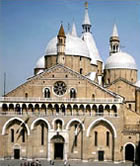Padova
History, art and culture

Situated in the geographical centre of Venetia region, Padua is one of the most culturally and economically alive and dynamic cities in the region.
Because of its centrality and the many rivers flowing through it, the area around Padua has been inhabited since the earliest times. In the 9th century BC, it became the cradle of early Venetia civilisation, and was one of the most important Roman cities in Roman Cisalpine Gaul.

It was, however, in the Middle Ages that development Padua and the surrounding area took place, both in territorial and economic terms. In the 13th century, when the powerful Commune of Padua dominated the area, the layout of the city was fixed, and a new age literally began. It was then that the city lived through its most important events: the foundation of the University, the building of the first Walls and the Palazzo della Ragione, Giotto's frescoes at the Scrovegni Chapel in the early 12th century, and the flourishing of such personalities as Pietro d'Abano, lecturer in medicine, philosophy, and science at the Sorbonne, Albertino Mussato, Marsilio da Padova, Lovato dei Lovati, etc.

The 12th century was Padua's siecle d'or, thanks partly to the enlightened rule of the Carrara dynasty. They it was who determined the fantastic artistic and cultural life (Giusto de' Menabuoi, Jacopo d'Avanzo, Altichiero, Petrarch, etc.), and Padua's political and military power throughout central Venetia. It is from this area that countless Castles can be traced back, as also the final layout of the many walled cities, still to be seen to the north and south of Padua. They are the consequence of bitter feuds and land claims between the Carrara dynasty, the Visconti and Della Scala families, and the Republic of Venice.

After a long siege, the Duke and his son went to Venice, to obtain favourable conditions of peace, but were detained and put to death (1405); the rule of the Carrara dynasty thus came to an end, and Padua fell to Venice. Thenceforth Padua followed the fortunes of Venice. Under Venetian rule, the very look of Padua changed, with the building of new walls and countless stately homes, government buildings in the Piazza dei Signori, and a new organisation for the various University buildings (Palazzo Bo, Botanical Gardens, Observatory, etc.). The University's prestige can be seen in names such as those of Copernicus, Galileo, G. F. d'Acquapendente, Poleni, G. B. Morgagni, etc.
In the field of arts, Padua's primacy was guaranteed throughout the 16th century by the works of di Donatello and Briosco, Squarcione and Mantegna, D. Campagnola and T. Aspetti, etc.
Venetian contributions came to an end in 1775 with the highly theatrical arrangement of the Prato della Valle, one of the largest squares in Europe.
Venetian noblemen must also be thanked for the countless villas and parks they built throughout the province, where the most famous architects, painters, and sculptors of the 16th, 17th, and 18th centuries worked (Palladium, Sansovino, Falconetto, Canova, Bonazza, Tiepolo, etc.), and which in many cases became the most flourishing artistic salons of the day for Venetian thinkers and writers (Ruzante, Goldoni, Gozzi).

The buildings in Padua which absolutely cannot be missed are the following: the Scrovegni Chapel, with the marvellous series of frescoes by Giotto, the 11th-century Palazzo della Ragione with its Salon, one of the largest hanging salons in the world, decorated with a cycle of 333 frescoes; the Cathedral, where Michelangelo worked and the nearby Baptistery, with frescoes by Florentine painter Giusto de' Menabuoi; Palazzo del Bo, the central University building with the Anatomical Theatre, the Hall of the Forty, were Galileo's chair is kept, and the Great Hall with its countless coats-of-arms of rectors and professors; the Basilica of St Anthony of Padua, on the pilgrim route of most of the world, containing priceless works of art and frescoes, painted between the 14th century and the modern day, the University Botanical Gardens, founded in 1545, the oldest in the world; the Prato della Valle, one of the biggest squares in Europe, the Church of Santa Giustina, rebuilt in 1502, crowned by eight cupolas, and with fourteen side chapels; there are paintings by Paolo Veronese, Luca Giordano, and Parodio. In addition to the relics of St Justina and St Luke, Evangelist, there is also the Chapel of St Prosdocimus, an example of early Christian art.